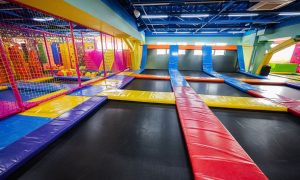Starting a recreation center can be a fulfilling endeavor, providing a community hub for health, wellness, and social interaction. Whether you want to open a space that offers sports activities, community events, or wellness programs, the process requires careful planning and strategic execution. This guide will provide you with an in-depth, step-by-step breakdown on how to open a recreation center that is both impactful and financially viable. We’ll go beyond the surface, offering unique insights and valuable details to help you get started on the right foot.
Establish Clear Objectives and Mission
The first step in opening a recreation center is defining what it stands for. A clear mission will shape your center’s direction and give it purpose. Start by answering these questions:
- What is the primary focus of the center? Is it sports, wellness, educational activities, or a combination?
- What are the core values that will guide your operations?
- How will the recreation center serve the community in a unique way?
Establishing well-defined objectives will help you communicate your vision clearly to stakeholders, potential donors, and community members. A powerful mission can also make it easier to secure funding and community support, as it will resonate with those who believe in your goals.
Conduct a Market Analysis

Before diving into the logistics, it is essential to conduct a thorough market analysis. Understanding your target market will help you identify potential gaps in services and ensure your recreation center offers something that the community truly needs. Here are the key components of a successful market analysis:
- Demographic Analysis: Examine population data to determine the demographics of the area. Are you aiming to attract young adults, families, seniors, or a mix of these?
- Community Needs Assessment: Conduct surveys or focus groups to understand what people in your area are looking for in a recreation center. Engaging directly with community members can help identify unmet needs.
- Economic Factors: Assess the average household income and spending power in the area to determine pricing strategies that are both accessible and sustainable.
- Industry Trends: Stay informed about recreation industry trends—such as the growing popularity of wellness programs and youth activities—to ensure your center stays relevant.
Identify Target Demographics
Your target demographic will play a pivotal role in shaping the services and programs you provide. Ask yourself:
- Are you targeting families, young professionals, children, or older adults?
- What specific needs or interests do these groups have?
By identifying and segmenting your target audience, you can tailor programs to their interests and ensure the recreation center appeals to a wide range of community members. For instance, young families may appreciate kid-friendly play areas, while older adults might prefer wellness classes like yoga or tai chi.
Analyze Competition
Understanding your competition is a key part of positioning your recreation center for success. Research existing facilities in your area—both public and private—to learn more about what they offer and identify gaps in their services. Analyze the strengths and weaknesses of your competitors, and use that information to create offerings that stand out.
Consider the following aspects while analyzing your competition:
- Programs and Services Offered: Are there any services that the competition doesn’t offer?
- Pricing Models: Study the pricing structures of competitors. Will you offer a more affordable option, or are you positioning your center as a premium facility?
- Location and Accessibility: Look into where competitors are located, and assess whether their location is an advantage or a disadvantage.
Develop a Comprehensive Company Summary
Your recreation center will need a strong foundation, starting with a comprehensive company summary. This document should include the following:
- Mission Statement: Reiterate the purpose of your center.
- Vision Statement: Describe the long-term goals of your facility.
- Values: Detail the core values that will guide your decision-making.
- Business Structure: Define whether you will operate as a nonprofit, LLC, or another business model.
- Summary of Services: Provide a broad overview of the services you will offer.
The company summary should be well-written and compelling, as it will be used in presentations to investors, lenders, or community partners.
Outline Start-Up Plan
Your start-up plan will help keep you organized and focused. Outline every major component needed to get the center operational, including:
- Initial Steps: Registering the business, obtaining necessary permits, and securing insurance.
- Funding Requirements: Identifying start-up costs such as property purchase or lease, renovations, equipment, and staffing.
- Milestones: Create a timeline with key milestones—such as location acquisition, renovation completion, and hiring staff.
Define Ownership Structure
The ownership structure of your recreation center is crucial for both legal and operational reasons. Determine whether you will run it as a sole proprietorship, a partnership, an LLC, or a nonprofit organization. Each structure has different implications:
- Nonprofit: This can make you eligible for grants and donations, but requires adherence to strict guidelines and governance.
- For-Profit LLC: Provides flexibility in operations and can attract investors, but might limit funding opportunities.
Consider consulting with a lawyer to choose the best ownership structure for your goals and circumstances.
Offer Diverse Products and Services
The range of products and services you offer will significantly impact the success of your recreation center. Diversity in offerings can attract a wider audience and maximize revenue. Here are some examples:
- Fitness Programs: Yoga, aerobics, martial arts, or personal training.
- Sports Facilities: Courts for basketball, tennis, or volleyball.
- After-School Programs: Offer educational and recreational activities for children and teenagers.
- Wellness and Education: Workshops on nutrition, mindfulness, or community-building.
By offering a variety of programs, you can meet different community needs and generate multiple revenue streams.
Create a Marketing and Sales Strategy
Once you’ve established what you want to offer, it’s time to create a marketing strategy to promote your recreation center. An effective marketing plan will include both traditional and digital approaches:
- Brand Identity: Develop a consistent brand—including a logo, tagline, and color scheme—that conveys your recreation center’s personality.
- Online Presence: Establish a website and active social media profiles to connect with the community.
- Events and Promotions: Host open house events and offer introductory discounts to attract new members.
- Partnerships: Collaborate with local schools, businesses, or community organizations to expand your reach.
Plan Operational Components
Smooth operations are essential for the day-to-day running of your recreation center. Key components to plan include:
- Membership and Payment Systems: Decide how members will join and pay for services. Will you offer monthly memberships, annual subscriptions, or pay-as-you-go options?
- Facility Maintenance: Develop a plan for cleaning, equipment upkeep, and repairs.
- Health and Safety: Establish protocols for emergencies, safety drills, and first aid.
Having these elements well-planned will allow you to deliver a high-quality experience to your patrons.
Establish an Online Presence
A strong online presence is crucial to the success of any modern business. Here’s how to ensure your recreation center stands out online:
- Website Development: Create a professional website that includes information about your programs, schedules, membership options, and contact details. Consider adding an online registration system for convenience.
- Search Engine Optimization (SEO): Incorporate keywords like “how to open a recreation center” throughout your website to improve visibility on search engines.
- Social Media Engagement: Use platforms like Facebook, Instagram, and Twitter to share updates, highlight events, and engage with the community.
- Local Listings: Register your recreation center on Google My Business and other local directories to increase visibility.
Personnel Planning and Staffing
Hiring the right people is vital to delivering a high-quality experience. Identify the types of employees you will need, including administrative staff, fitness instructors, maintenance staff, and customer service representatives.
- Job Descriptions: Clearly define the roles and responsibilities of each position.
- Hiring Process: Develop a hiring process that includes background checks, interviews, and practical skill assessments.
- Training and Development: Invest in training programs to ensure staff are knowledgeable, friendly, and competent in their roles.
Draft Financial Projections
To secure funding, you’ll need to present detailed financial projections. These projections should cover at least the first three years of operation and include:
- Revenue Streams: Identify where your income will come from—membership fees, classes, equipment rentals, sponsorships, etc.
- Start-Up Costs: Include expenses such as facility acquisition, renovations, equipment, staffing, and marketing.
- Operational Costs: Detail the ongoing expenses, including staff salaries, utilities, maintenance, and marketing.
- Break-Even Analysis: Calculate when you expect the recreation center to become profitable.
Secure Necessary Funding
Once your financial projections are in place, you can start looking for funding. Here are some options to consider:
- Small Business Loans: Approach banks or credit unions for loans.
- Grants: Research grants for community centers or recreational projects. Nonprofits may have access to a wider variety of grants.
- Crowdfunding: Launch an online crowdfunding campaign to generate community support and raise funds.
- Private Investors: Seek out investors who are interested in supporting community-based projects.
Scout for an Appropriate Location
Location is a critical factor for a successful recreation center. Choose a site that is easily accessible and located within your target market’s vicinity. Consider the following when scouting locations:
- Visibility: The center should be easy to find, with ample signage opportunities.
- Accessibility: Ensure there is adequate parking and that the facility is accessible by public transportation.
- Space Requirements: Choose a facility that has enough space for your planned activities, along with room for expansion if needed.
Obtain Licenses and Permits
To legally operate a recreation center, you will need to obtain certain licenses and permits. These can vary depending on your location and the services you provide, but typically include:
- Business License: Required to legally operate in your area.
- Building Permits: For any renovations or construction work.
- Health and Safety Permits: Depending on the activities offered, such as pool safety permits or food handling licenses.
Consult with local authorities to determine the specific requirements in your area.
Design an Efficient Facility Layout
The layout of your recreation center will greatly impact its functionality and the user experience. When designing the layout, consider the following:
- Activity Zones: Create designated areas for specific activities—such as a gym area, sports courts, classrooms, and relaxation areas.
- Flow of Movement: Ensure there is a logical flow of movement that minimizes congestion and allows for easy navigation.
- Accessibility: Ensure all areas are accessible to individuals with disabilities, including ramps, elevators, and accessible bathrooms.
A well-designed layout will make your recreation center more welcoming and enjoyable for all users.
Implement Ongoing Community Engagement Strategies
Your recreation center should be an integral part of the community. To foster this connection, engage with the community regularly through the following:
- Community Events: Host events such as open houses, free classes, or community fairs.
- Feedback Opportunities: Provide opportunities for community members to share feedback, such as surveys or suggestion boxes.
- Partnerships: Collaborate with local schools, businesses, and other organizations to create joint events or programs.
Ongoing community engagement will help maintain a positive reputation and foster loyalty among members.
Provide Superior Customer Service

Great customer service is key to retaining members and creating a positive atmosphere. Train your staff to be friendly, helpful, and attentive. Establish clear policies for handling customer concerns and complaints to ensure they are resolved promptly and effectively.
Regularly Assess Performance and Feedback
To ensure your recreation center continues to meet the needs of the community, regularly assess performance and gather feedback. Key methods include:
- Surveys and Feedback Forms: Ask members for their input on programs, facilities, and staff.
- Financial Analysis: Review your financial performance regularly to assess profitability and areas for improvement.
- Staff Meetings: Hold regular meetings to discuss challenges, successes, and ways to enhance the customer experience.
Use the information gathered to make informed decisions and keep your recreation center on the path to success.
Conclusion
Opening a recreation center is an ambitious yet rewarding undertaking. By following the steps outlined in this guide—from establishing clear objectives to creating a welcoming community environment—you’ll be well on your way to building a successful and impactful facility. A well-run recreation center can become the beating heart of a community, providing a place for people to learn, grow, and connect.
ALSO READ: Can a Foreigner Open a Restaurant in Thailand?
FAQs
The cost can vary widely depending on factors like location, facility size, and services offered. Generally, start-up costs can range from $500,000 to over $5 million.
The timeline can range from a few months to over a year, depending on factors such as securing funding, obtaining permits, and completing renovations.
Yes, a detailed business plan is essential to guide your start-up efforts and secure funding.
Incorporate accessibility features like ramps, elevators, and accessible restrooms, and ensure all programs are inclusive.




